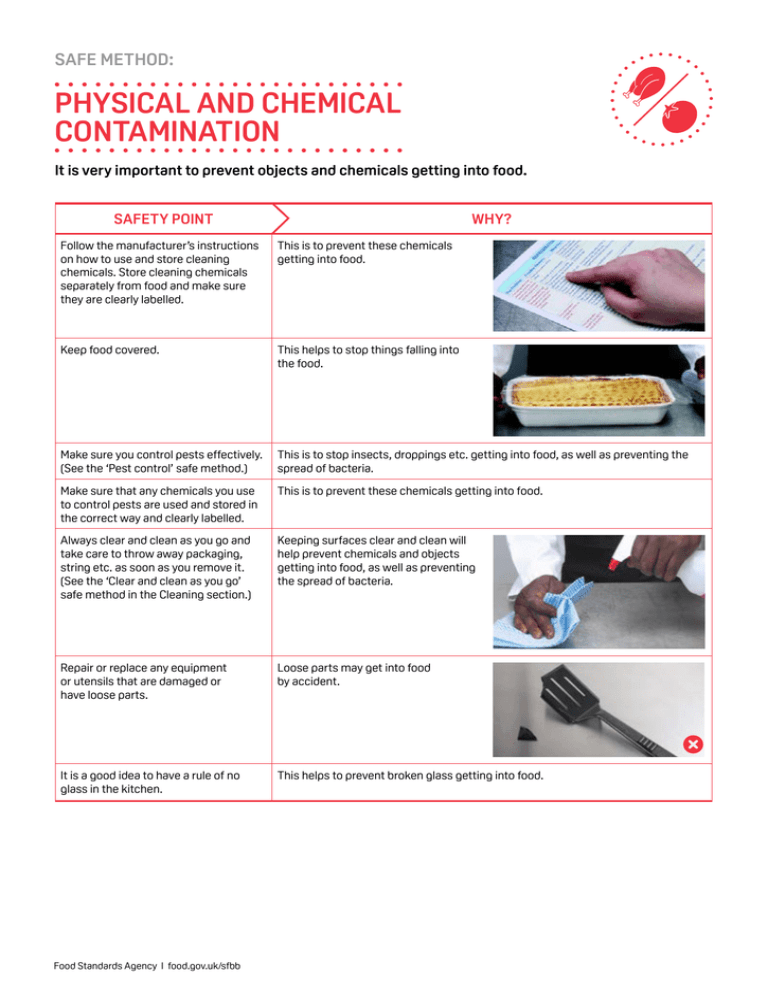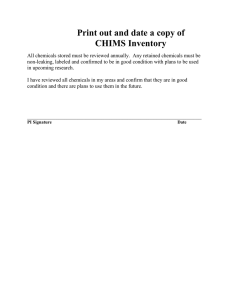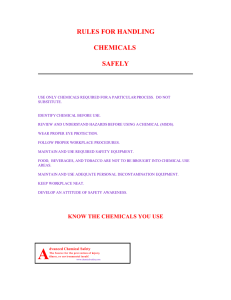safe method: physical and chemical contamination
advertisement

SAFE METHOD: PHYSICAL AND CHEMICAL CONTAMINATION It is very important to prevent objects and chemicals getting into food. SAFETY POINT WHY? Follow the manufacturer’s instructions on how to use and store cleaning chemicals. Store cleaning chemicals separately from food and make sure they are clearly labelled. This is to prevent these chemicals getting into food. Keep food covered. This helps to stop things falling into the food. Make sure you control pests effectively. (See the ‘Pest control’ safe method.) This is to stop insects, droppings etc. getting into food, as well as preventing the spread of bacteria. Make sure that any chemicals you use to control pests are used and stored in the correct way and clearly labelled. This is to prevent these chemicals getting into food. Always clear and clean as you go and take care to throw away packaging, string etc. as soon as you remove it. (See the ‘Clear and clean as you go’ safe method in the Cleaning section.) Keeping surfaces clear and clean will help prevent chemicals and objects getting into food, as well as preventing the spread of bacteria. Repair or replace any equipment or utensils that are damaged or have loose parts. Loose parts may get into food by accident. It is a good idea to have a rule of no glass in the kitchen. This helps to prevent broken glass getting into food. Food Standards Agency l food.gov.uk/sfbb WHAT TO DO IF THINGS GO WRONG HOW TO STOP THIS HAPPENING AGAIN • If chemicals or objects, such as glass, insects or coloured waterproof dressings get into food, throw the food away. • Review how you use and store chemicals in your business. • If you find pests or signs of pests, take action immediately. (See the ‘Pest control’ safe method.) • Train staff again on this safe method. • If you find objects in food that has been delivered, reject the delivery, if possible, and contact your supplier immediately. • Review your pest control arrangements. • Improve staff supervision. Write down what went wrong and what you did about it in your diary. THINK TWICE! When you clean work surfaces, make sure that any cleaning chemicals you use are suitable for surfaces touched by food. Check the manufacturer’s instructions on how they should be used. THINK TWICE! Covering foods It is important to keep food covered to help protect it from harmful bacteria. This is especially important for cooked food and other ready-to-eat food. Always use containers or bags that have been designed to store food. Suggested food coverings include kitchen foil, cling film, plastic boxes with lids or freezer bags. Keep unused food coverings clean and separate from food. When you are covering food: • Check the manufacturer’s instructions to see if the covering is suitable for what you are using it for. • Always make sure that the food is properly covered. • Take care not to let the covering fall into foods. • Never re-use foil, cling film or freezer bags and do not store food in opened tins. • Make sure that plastic boxes are washed, disinfected and dried between uses. Avoid re-using food packaging to store food. Often packaging is designed to be used once with a certain food, so it might not be safe to use it again, or to use it with a different food. If food packaging is used in a way that it was not designed for, chemicals could transfer into the food. Instead, use re-usable containers that have been designed to store food. Food Standards Agency l food.gov.uk/sfbb



